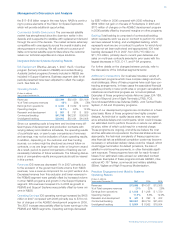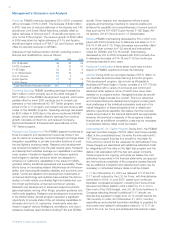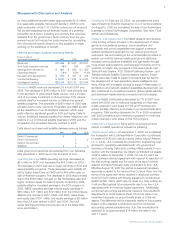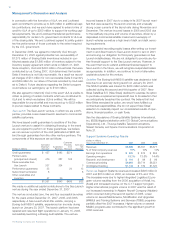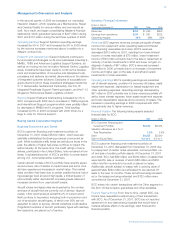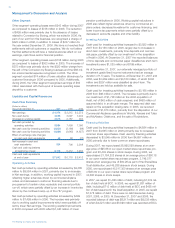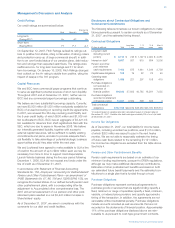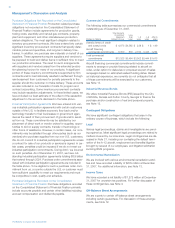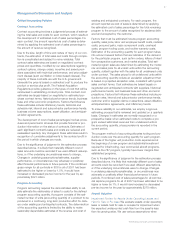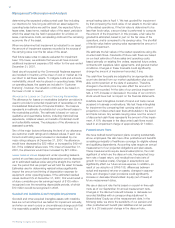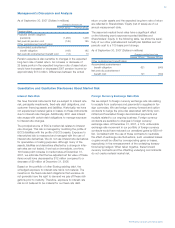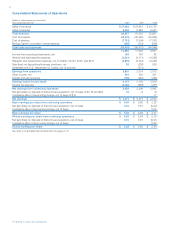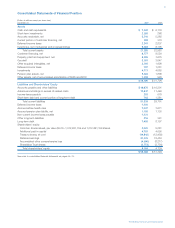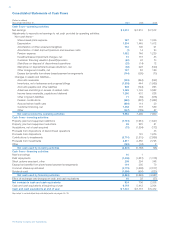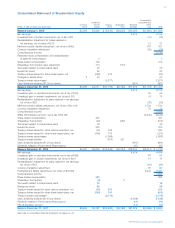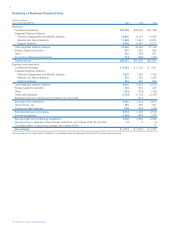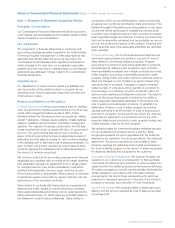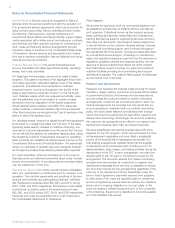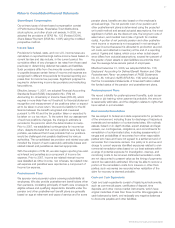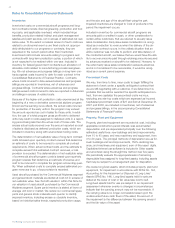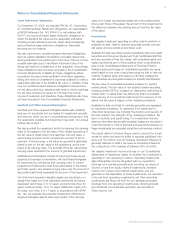Boeing 2007 Annual Report Download - page 42
Download and view the complete annual report
Please find page 42 of the 2007 Boeing annual report below. You can navigate through the pages in the report by either clicking on the pages listed below, or by using the keyword search tool below to find specific information within the annual report.
39
Management’s Discussion and Analysis
As of September 30, 2007 (Dollars in millions)
Change in discount rate
Increase 25 bps Decrease 25 bps
Pension plans
Projected benefit obligation
(pensions) (1,263) 1,436
Net periodic pension cost (145) 155
Other postretirement benefit plans
Accumulated postretirement
benefit obligation (168) 185
Net periodic postretirement benefit cost (14) 13
Pension expense is also sensitive to changes in the expected
long-term rate of asset return. An increase or decrease of
25 basis points in the expected long-term rate of asset return
would have increased or decreased 2007 pension income by
approximately $114 million. Differences between the actual
return on plan assets and the expected long term rate of return
are reflected in Shareholders’ Equity (net of taxes) as of our
annual measurement date.
The assumed medical trend rates have a significant effect
on the following year’s expense recorded liabilities and
Shareholders’ Equity. In the following table, we show the sensi-
tivity of our other postretirement benefit plan liabilities and net
periodic cost to a 100 basis point change.
As of September 30, 2007 (Dollars in millions)
Change in medical trend rate
Increase 100 bps Decrease 100 bps
Other postretirement benefit plans
Accumulated postretirement
benefit obligation 621 (545)
Net periodic postretirement
benefit cost 121 (109)
Quantitative and Qualitative Disclosures About Market Risk
Interest Rate Risk
We have financial instruments that are subject to interest rate
risk, principally investments, fixed-rate debt obligations, and
customer financing assets and liabilities. Historically, we have
not experienced material gains or losses on these instruments
due to interest rate changes. Additionally, BCC uses interest
rate swaps with certain debt obligations to manage exposure
to interest rate changes.
The principal source of BCC’s market risk relates to interest
rate changes. This risk is managed by matching the profile of
BCC’s liabilities with the profile of BCC’s assets. Exposure to
mismatched risk is measured and managed with the use of
interest rate derivatives. We do not use interest rate derivatives
for speculative or trading purposes. Although many of the
assets, liabilities and derivatives affected by a change in inter-
est rates are not traded, if we had an immediate, one-time,
100 basis-point increase in market rates at December 31,
2007, we estimate that the tax-adjusted net fair value of these
items would have decreased by $12 million compared to a
decrease of $9 million at December 31, 2006.
Based on the portfolio of other Boeing existing debt, the
unhedged exposure to interest rate risk is not material. The
investors in the fixed-rate debt obligations that we issue do
not generally have the right to demand we pay off these obli-
gations prior to maturity. Therefore, exposure to interest rate
risk is not believed to be material for our fixed-rate debt.
Foreign Currency Exchange Rate Risk
We are subject to foreign currency exchange rate risk relating
to receipts from customers and payments to suppliers in for-
eign currencies. We use foreign currency forward and option
contracts to hedge the price risk associated with firmly com-
mitted and forecasted foreign denominated payments and
receipts related to our ongoing business. Foreign currency
contracts are sensitive to changes in foreign currency
exchange rates. At December 31, 2007, a 10% unfavorable
exchange rate movement in our portfolio of foreign currency
contracts would have reduced our unrealized gains by $69 mil-
lion. Consistent with the use of these contracts to neutralize
the effect of exchange rate fluctuations, such unrealized losses
or gains would be offset by corresponding gains or losses,
respectively, in the remeasurement of the underlying transac-
tions being hedged. When taken together, these forward
currency contracts and the offsetting underlying commitments
do not create material market risk.
The Boeing Company and Subsidiaries


